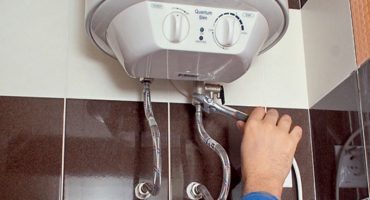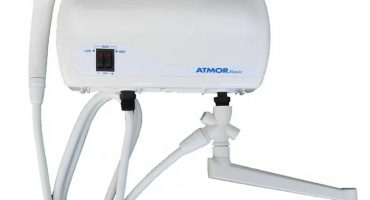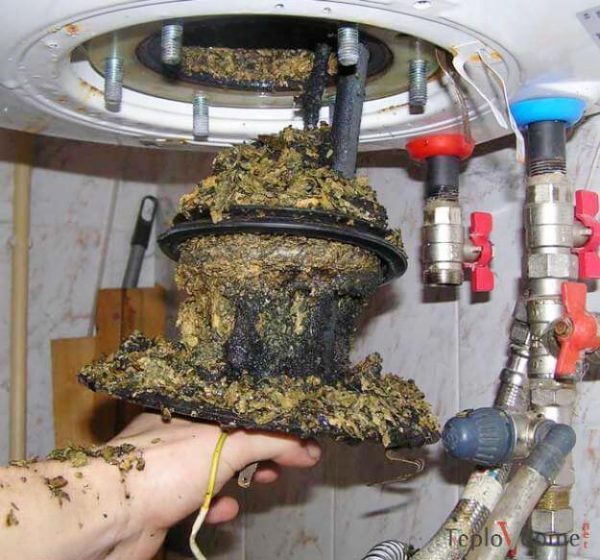
Without a cold water filter, the EVN will quickly fail
An electric water heater is used to heat water to the temperature necessary for a person and maintain it in this state for a long time. The main and main element of all devices is a heating element with a water tank. If in gas boilers a gas burner serves as a heating element, then in electric heaters it is a metal heater. To determine the best EVN, it is necessary to determine what requirements it must meet, and how they differ from each other.
What is a flow-through electric heater?
Electric instantaneous water heaters waters have the following properties:
- They require a small installation space.
- A small volume of water quickly heats up to operating temperature.
- The heating rate depends on the power of the heating elements (up to 30 kW).
- TEN is sensitive to air traffic jams.
- They work on heating water only during washing.
Instantaneous water heaters have the following structural elements that provide quick heating of water:
- Strong external metal contour.
- TEN for heating.
- Air plug sensor.
- Temperature switch.
- Entering cold water.
- Release of hot water.
Models may differ in additional devices, but the basic composition of the elements remains the same for everyone.

For any apartment, you can choose an electric water heater
According to the principle of operation, flow-through EHVs are divided into pressure and non-pressure ones.
Pressure water heaters Assume insertion directly into the pipe. This leads to the fact that such devices experience the pressure of the water supply network, this happens regardless of whether the heater is used or not. In this type of heater, the material and strength of the tank where the water is heated is very important.
In addition, pressure devices are equipped with a safety system, which includes a fuse, pressure reducer and check valve. Using these devices creates uninterrupted operation of the water heater.
Non-pressure water heaters They are not built into the water supply system, but are cut off from it by means of shut-off valves. A standard tap must be installed in front of the flow devices. If this is a storage heater, then a special mixer is required to install it. In such devices, as a rule, high pressure is not created. Therefore, plastic tanks can be used for operation. Their advantage is not only cheapness, but also that they are not subject to corrosion and hold heat relatively well. Among the shortcomings can be noted their insignificant volume, which is limited to 30 liters.
The main characteristics of electric instantaneous water heaters
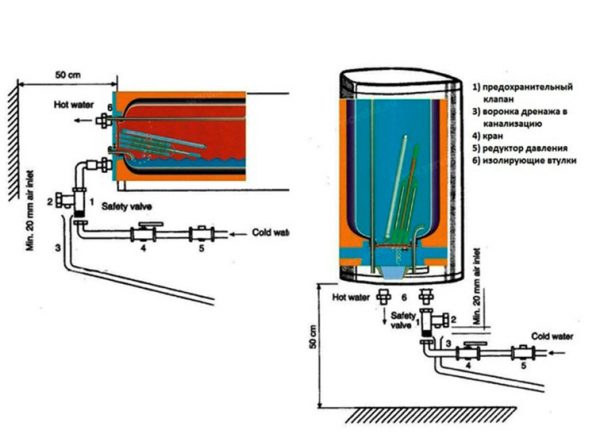
Power Connection Diagram
When choosing heaters, it is necessary to compare according to several characteristics. Initially selected by the overall dimensions of the installation site. Select several samples of water heaters (pressure or non-pressure). In addition, each sample should be optimally connected to the electric and water distribution network. It should have free access for maintenance (management).Then, a heater is determined that will provide the necessary performance during operation in specific conditions. The necessary need depends on the number of families, on the proposed water procedures (washing hands 3 l / min; washing dishes 5 l / min; bath 8 l / min).
It should be borne in mind that about an equal amount of electricity is used for heating 1 liter in modern European models of heaters. Therefore, this characteristic will be approximately the same for all selected samples. The price may differ only when using different materials in the manufacture of the tank and the heating element, provided that all heaters have safety devices. Having selected several samples with the same characteristics, it is necessary to solve the design issue.
The appearance of the selected electric instantaneous water heaters should fit into the interior of the room. For the durability of the heater, the material of the tank, the design of the heaters (dry or wet) and the control system of the heating elements (mechanical or electronic) are of importance.
Electric instantaneous water heaters
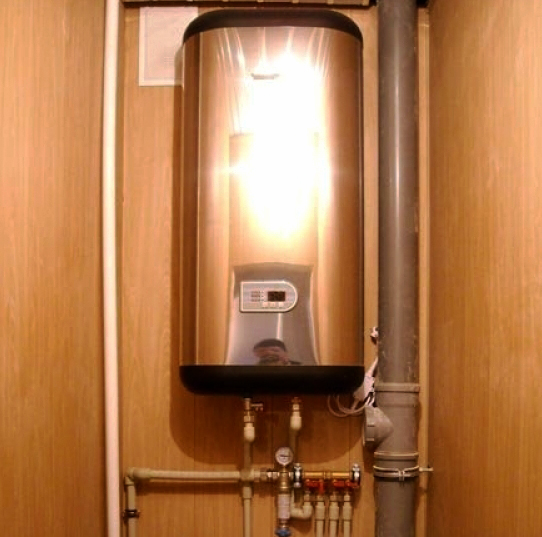
The optimal place for mounting the EVN
The compact form of the heater makes it possible to mount the installation in the cramped conditions of a modern apartment. Such heaters are storage (capacitive). The choice of sizes and shapes is carried out for a specific room of the apartment. The structure includes a tank with a capacity of 65-100 liters. TENY heat water to a temperature of 70 degrees, previously installed on the rheostat. Using hot water mixed with cold, we get a mixture of 30 degrees. Cold water through pipes of domestic domestic water supply (a well with a deep pump or urban water supply) enters the tank with heating elements.
Filling the tank to the top with water, the shut-off valve is activated. When the water in the tank warms up to the set temperature, a rheostat is triggered shutting off the supply of electricity to the heating elements. Opening the faucet with hot water, the level in the tank drops and the valve with cold water automatically opens, the heating elements turn on. Turning on (turning off) the hot water tap, you can adjust the temperature in the water heater. To drain the water from the tank during cleaning, it is necessary to provide a valve with a hose on the inlet tee in the cold water supply system. Knowing the quality of water (rarely complies with GOST), it is necessary to provide for the installation of a filter.
Instantaneous pressure water heater

Pressure head EVN in a bathroom
The basic scheme of operation of a pressurized flow-through EHV consists in the need to obtain hot water of a certain temperature without a time limit (shower). If you choose a heater with a capacity of 8 l / min, setting the temperature regulator at 40 degrees, then the whole family will wash in the cabin without additional operations with water or electricity. Automation will perform all operations.
What you need to pay attention to when choosing a water heater:
- Name + price.
- Estimated load (shower + faucet).
- Country producer + warranty period.
- The presence of a water filter.
- TENA material and productivity in l / min.
- How temperature and heating power are regulated, power consumption.
- Option for installing and connecting pipes (horizontally or vertically).
- Overall dimensions and own weight. Inlet pressure. Necessary voltage (220 V) and diameter of branch pipes.
Pressure or non-pressure water heater: advantages and disadvantages
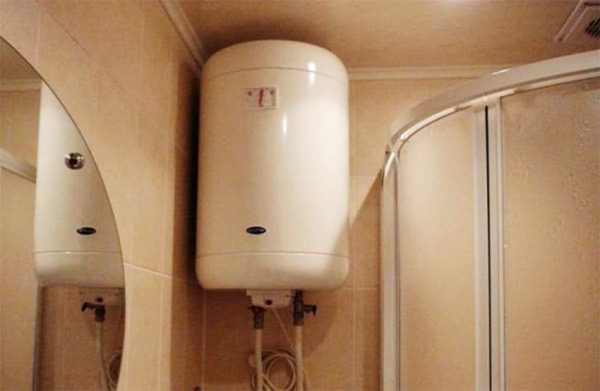
EVN near the shower
From the point of view that it is easier to operate a pressure or non-pressure water heater, the best option is pressure. To start, you just need to open the faucet with hot water, set the temperature regulator to 40 (for the shower) degrees and start using it. There is no need to turn on electricity - it is already connected. The water tank is always full and corresponds to the working pressure in the network.All operations with adjustments work in automatic mode. If it is necessary to use two or more points at the same time (shower and dishwasher) while maintaining a constant temperature, a flow-through pressure heater will be the best option for a large family.
The choice of electric flow heater is based on the total number of volumes of flow of hot water per minute. In the absence of the necessary conditions for the pressure head, it is necessary to use a pressureless flow heater. Choosing a non-pressure water heater, we obtain an apparatus that is easy to operate, but requiring an additional several operations. Turn on the cold water tap and fill the tank of 100 liters. Then we turn on the electric network and set the temperature of hot water to 70 degrees. Turn on the heating elements. We are waiting for some time. The thermostat should turn off the water heating. Open the tap with hot (diluting cold) water. After washing, all operations are performed in the reverse order.
When comparing the qualities of a pressure-through flow heater with a pressure-free flow heater, it is difficult to choose the best. The difference between them is small.
If the mains is not designed for high power consumers, it is preferable to choose a pressure-free flow heater.
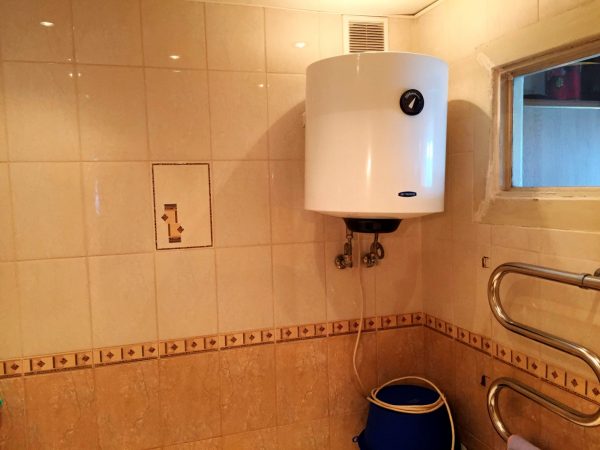
Pressureless EVN in the bathroom
If the water supply system has a weak, unstable working pressure with frequent shutdowns and dirty water, then the use of a pressure heater is not recommended.
The heater must have dry heaters. When supplying water from local sources to the insulated storage tank in the attic, only a non-pressure instantaneous water heater with dry heating elements is recommended.
Having all the necessary conditions and significant cash restrictions, you can choose a pressure-through flow heater (6 kW, 3 l / min) for 3.5 thousand rubles.
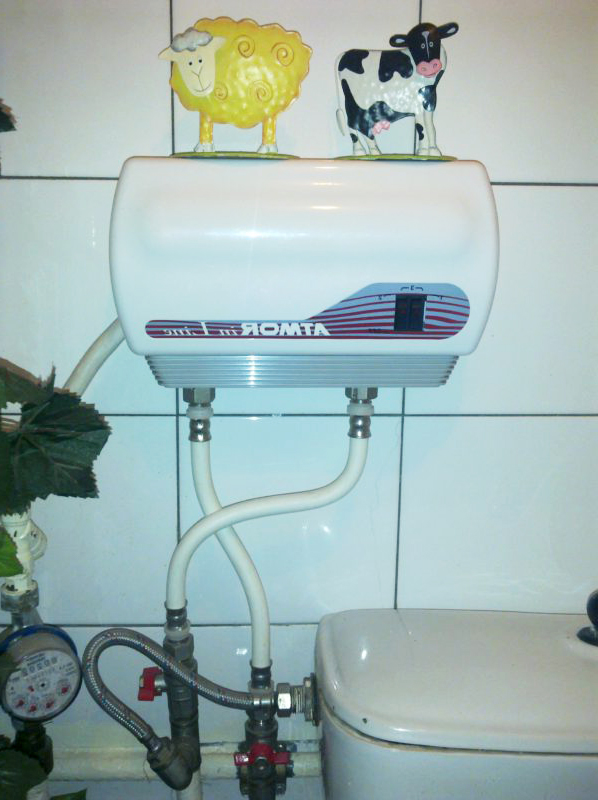
Budget option pressure head EVN
This power allows you to abandon centralized hot water and use only cold water. Grounding or grounding of the heater is required. Mandatory installation of a disconnecting protective device of the mains. It is better if the installation of the water heater is performed by a professional electrician in compliance with all the rules.

